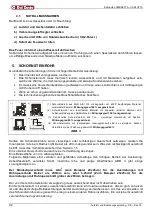
Chimney stove
OMBRETTA - CARLOTTA
20
Instructions for installation and use – EN – Rev.05
DO NOT EXTINGUISH FIRE USING WATER JETS.
When the fire has been extinguished, let the flue check by an expert to find possible cracks and permeable
points.
5. CANNA FUMARIA
Essential requirements for a correct operation of the
appliance:
•
the internal section must be preferably circular;
•
be thermally insulated and water-proof and
produced with materials suitable to resist to heat,
combustion products and possible condensates;
•
not be throttled and show a vertical arrangement
with deviations not greater than 45°;
•
if already used, it must be clean;
•
observe the technical data of the instructions
manual;
Should the flues have a square or rectangular section,
internal edges must be rounded with a radius not lower
than 20 mm. For the rectangular section, the maximum
ratio between the sides must be
≤
1.5.
A too small section causes a decrease of the draught. It is
suggested a minimum height of 4 m.
The following features are forbidden and therefore they
endanger the good operation of the appliance: asbestos
cement, galvanized steel, rough and porous internal
surfaces. Picture 3 gives some examples of execution.
The minimum section must be 4 dm
2
(for example 20
x 20 cm’s) for appliances whose duct diameter is
lower than 200 mm, or 6.25 dm
2
(for example 25 x 25
cm’s) for appliances with diameter greater than 200
mm.
The draught created by the flue must be sufficient, but not excessive.
A too big flue section can feature a too big volume to be heated and consequently cause difficulties in the
operation of the appliance; to avoid this, tube the flue along its whole height. A too small section causes a
decrease of the draught.
The flue must be properly spaced from any flammable materials or fuels through a proper
insulation or an air cavity.
It is forbidden to let plant piping or air feeding channels pass in the same flue. Moreover, it is forbidden to
create movable or fixed openings on the same for the connection of further other appliances.
5.1. CHIMNEY CAP
The draught of the flue depends also on the suitability of the chimney cap.
Therefore, if it is handicraft constructed, the output section must be more than twice as big as the internal
section of the flue.
Picture 3
A+1/2A
A
Max.
A+1/2A
(3)
(1)
(2)
(4)
(1) AISI 316 steel flue with double chamber
insulated with material resistant to 400°C.
Efficiency 100% excellent.
(2) Refractory flue with double insulated chamber
and external coating in lightweight concrete.
Efficiency 100% excellent.
(3) Traditional clay flue square section with
cavities. Efficiency 80% excellent.
(4) Avoid flues with rectangular internal section
whose ratio differs from the drawing. Efficiency
40% poor.
















































